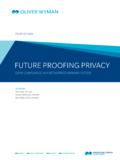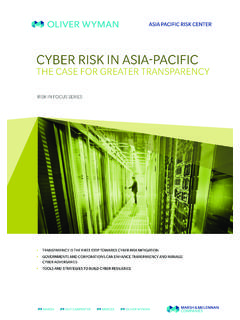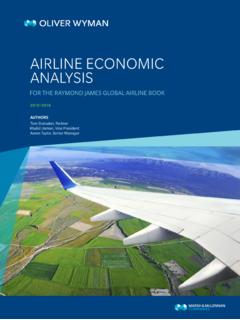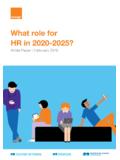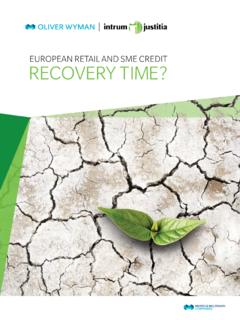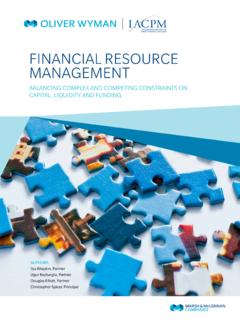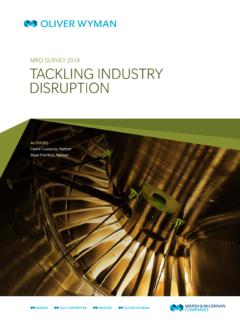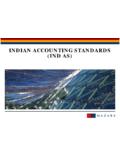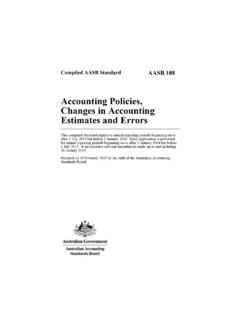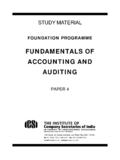Transcription of CURRENT EXPECTED CREDIT OSS L CECL( …
1 CURRENT EXPECTED CREDIT LOSS ( cecl ) accounting IT S TIME TO GET MOVINGAUTHORS Ross Eaton, PartnerDaniel Cope, PartnerJustin Chen, Engagement ManagerCURRENT EXPECTED CREDIT LOSS ( cecl ) accounting : IT S TIME TO GET MOVINGAs a result of the Financial accounting Standards Board s (FASB s) changes to CREDIT loss accounting , financial institutions will require additional capital and will need to make significant changes to their loss forecasting methodology and infrastructure. FASB ASC 326 requires a move to allowances based on CURRENT EXPECTED CREDIT losses ( cecl ), forcing financial institutions to estimate EXPECTED losses over the life of most CREDIT exposures not subject to fair value accounting .
2 The impact is most significant for banks, but insurers and other financial institutions with CREDIT portfolios will also be is important because: It requires a change in mindset from a backward-looking to a forward-looking approach in setting allowances for CREDIT losses. It will increase allowances and reduce capital for most institutions. ROEs for many products will fall, likely leading to changes in product structure and pricing. Significant changes will be required to institutions' loss forecasting models, infrastructure and systems, necessitating significant coordination across the implementation date the end of 2019 for most large institutions may seem like a long way off, but financial institutions will need that time to prepare.
3 We recommend a series of steps to ensure firms meet that deadline without undue stress. In particular, we suggest institutions: Immediately establish a formal cecl program. Conduct a comprehensive gap assessment on loss forecasting methodologies, data, systems and controls. Identify resource requirements and begin hiring. Educate the Board and senior management on the changes and their impacts. Explore changes to product design, pricing and collections 2017 Oliver Wyman 2 Exhibit 1.
4 Summary of key implications of cecl for financial institutionsKEY IMPACT AREASIMPLICATIONS Larger allowances for most products and lower capital ratios Additional volatility in allowances and capital ratiosCAPITAL RATIOS Overall reduction in ROE, greatest for products with longer EXPECTED lifetimes ( mortgages, commercial real estate) and high risk, high return segments As a result, changes to product structuring, pricing, collections practices, securitization and loan sales PRODUCT PROFITABILITY More granular disclosures Significantly greater challenge to explain results to stakeholders and to account for changes from period to period within public reporting deadlinesDISCLOSURES Integration of a large number of risk and finance data elements across a broad range of business functions Sarbanes-Oxley controls over data and systems, and external audit of resultsDATA MANAGEMENT More regular, rapid production of loss forecasts (as frequently as daily)
5 As a resultSYSTEMS AND PROCESSES Significant methodological challenges requiring new models or adjustments to existing approachesLOSS FORECASTINGMETHODOLOGY Generation of macro-economic forecasts Accuracy of benign period and near term forecasts Increased importance of prepayment forecasts Reversion from forecasts to historical estimates Supervisory treatment of unconditionally cancellable commitments Forecasting of future allowances and provisions Greater automation and integration of systems to support complete automation (in the case of daily runs) Expanded technology capacity and capability to support multiple concurrent model runs and reduced cycle timeSource: Oliver WymanCopyright 2017 Oliver Wyman 3 BACKGROUND AND TIMINGIn June 2016, FASB issued its new accounting standard for recognizing allowances for CREDIT losses, including the cecl methodology.
6 Under cecl , for assets measured at amortized cost ( most loans, leases, CREDIT lines and Held To Maturity securities), financial institutions are required to provision for EXPECTED losses over the full contractual term of the asset in advance, as described in Exhibit 2: cecl at a glanceScope of cecl allowances Loans, debt securities (except AFS1), trade receivables, net investments in leases, off-balance-sheet CREDIT exposures, reinsurance receivables, and receivables that relate to repurchase agreements and securities lending agreementsTiming of loss recognition Immediate recognition of all EXPECTED CREDIT losses over the contractual termMeasurement requirements Beyond the period for which reasonable and supportable forecasts are obtainable, banks may rely on historical information alone Assets with similar risks are to be assessed collectively (pooled)
7 When such characteristics exist this seeks to reduce zero-loss estimates No methodology is prescribed, though a number of possible methodologies are AFS securities, the CURRENT OTTI model continues to apply, with some targeted improvements Source: Oliver WymanCECL is effective for reporting periods beginning after December 2019 for SEC filers, with an option for early adoption. Meanwhile, the International accounting Standards Board s (IASB s) similar IFRS 9 standard was finalized in 2014, and is effective for reporting periods beginning on or after January 1st, 2018. US banks with substantial international business and large Foreign Banking Organizations operating in the US will therefore have an opportunity to learn from their IFRS 9 experience as they prepare for 3: Key dates for cecl and IFRS 91 IFRS 9 NON US cecl US E ective Date(Canada)Learn from IFRS 9 challenges and prepare for CECLT imelineEarly Adoption permittedE ective Date: SEC filersE ective Date: Non-SEC filersRegulatory reporting for early adoptersRegulatory reporting for SEC filersRegulatory reporting for Non-SEC filersE ective Date(UK/EU)DEC 152018 JAN12018 NOV12017 DEC 152019 DEC 152020 MAR 312019 MAR 312020 MAR 3120211.
8 A distinction exists between public business entities that do not file with the SEC and private companies private companies may delay cecl reporting for interim periods until fiscal years beginning after December 15, 2021. Source: Oliver WymanCopyright 2017 Oliver Wyman 4 KEY CHALLENGES AND IMPLICATIONS FOR FINANCIAL INSTITUTIONSLOWER AND MORE VOLATILE CAPITAL RATIOSI mplementation of cecl will result in larger allowances for most products and therefore lower capital ratios.
9 With some commentators estimating a reduction in industry common equity tier 1 ratios of as much as once fully phased In addition to the initial impact, institutions will suffer a drain on capital during periods of strong CREDIT growth, since the higher provisions are booked upfront, before any income is is also likely to introduce greater volatility in provisions, P&L and capital ratios (though not to the extent of IFRS 9, since cecl does not have the staging concept of IFRS 9 see Exhibit 6 for details). To assess the stability of their cecl allowances, we recommend institutions conduct extensive sensitivity testing on their models, assumptions and scenario development offset the increase in allowances and absorb this greater volatility, institutions will need additional PROFITABILITYWith significantly higher provisions booked upfront, some product ROEs will fall.
10 The impact will be greater for products with longer EXPECTED lifetimes ( mortgages, commercial real estate), and lower (even positive) for those with short contractual maturities ( undrawn balances on CREDIT cards, or commercial lines with short renewal periods). It will also disproportionally affect high risk, high return products ( revolver CREDIT card portfolios) since the provisions will now be now front-loaded before any revenue can be 4: How will different products fare under cecl ?Significantly higher allowances/Lower profitability Mortgages HELOC CREDIT cards ( revolver accounts) Commercial real estate Commercial lending LeasesLittle impact or lower allowances/Higher profitability CREDIT cards ( transactor or low utilization accounts) Other unconditionally cancellable lines Commercial lines with short renewal periods Source: Oliver Wyman1 The American Bankers Association (ABA) has recently lobbied the Basel Committee on Banking Supervision (BCBS) for a transition timeline of no less than five years for the inclusion of cecl allowances in regulatory capital ratios.

